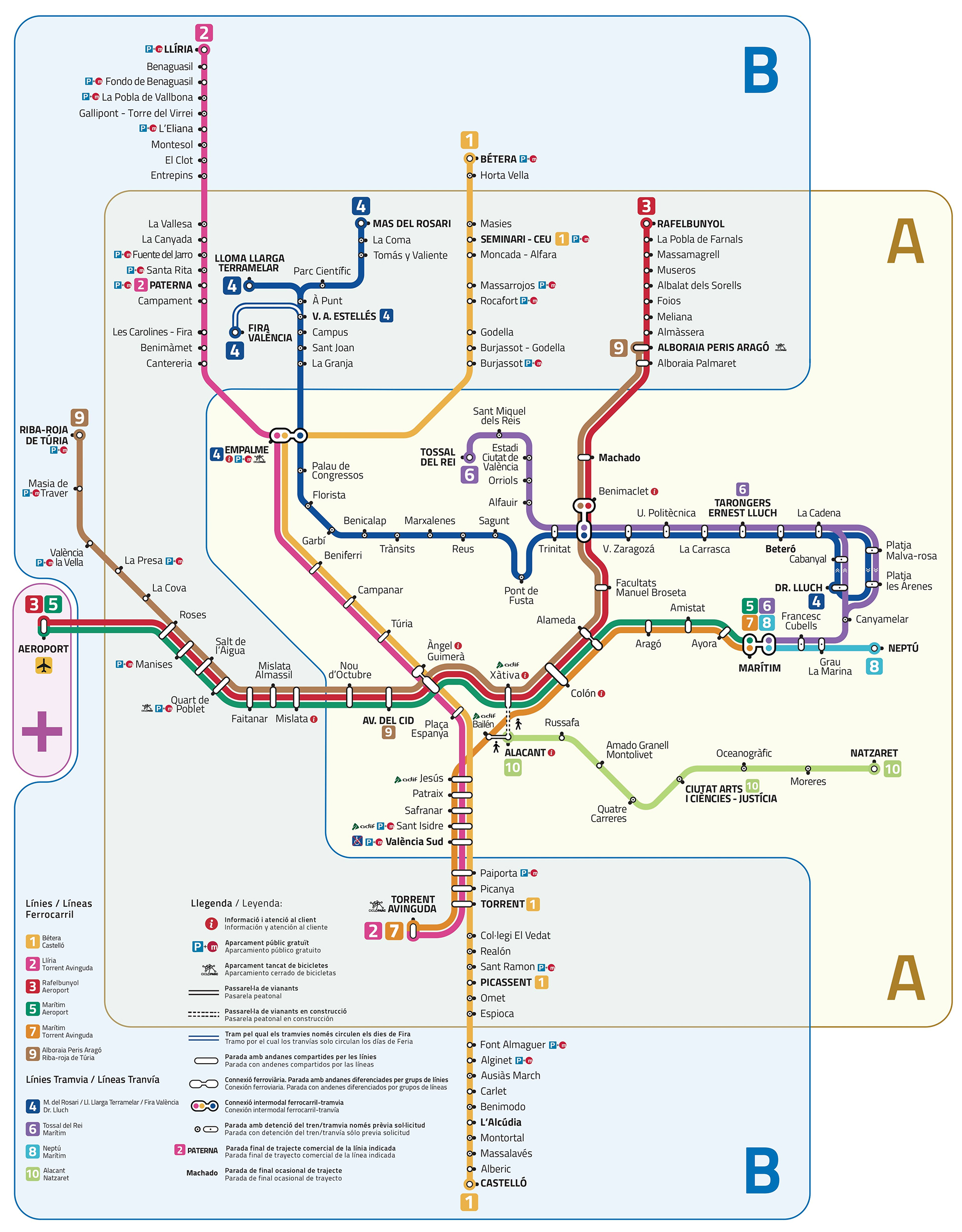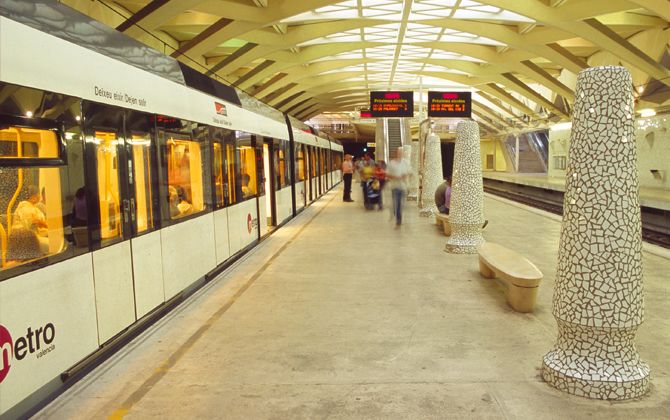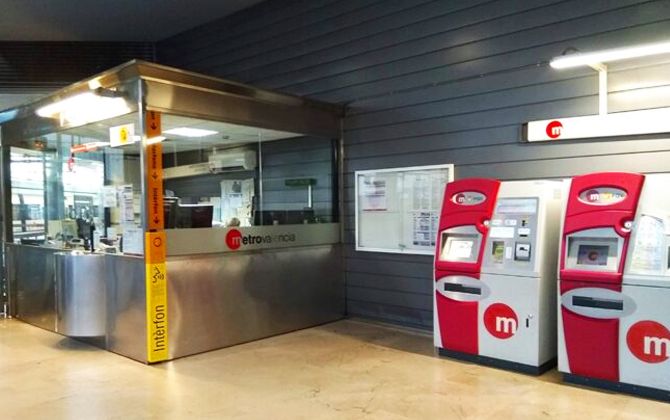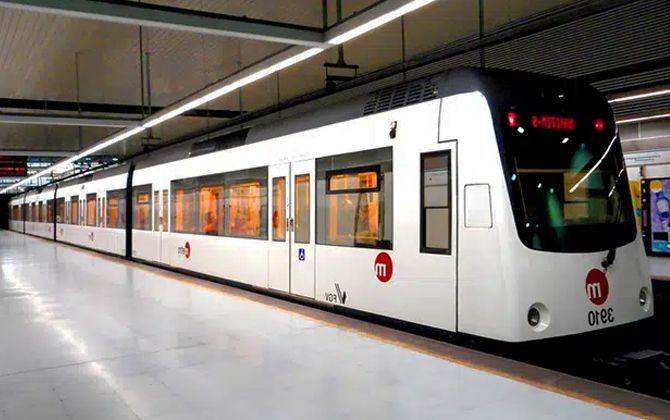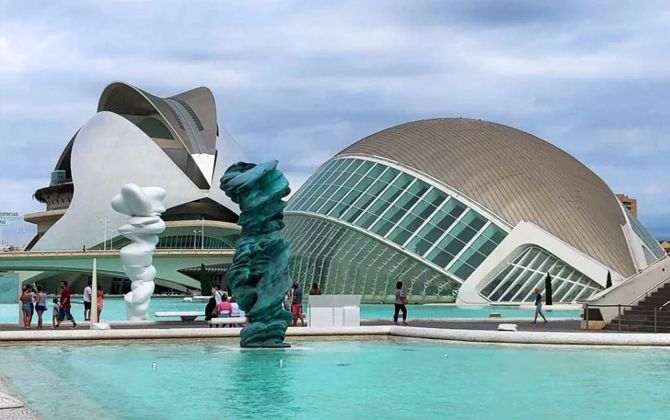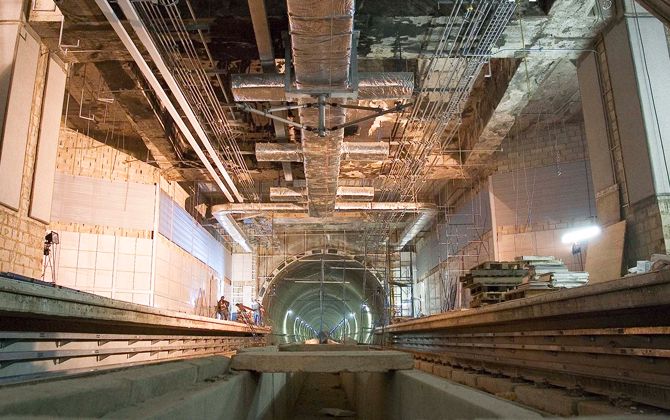The Valencia Metro (Metrovalencia) is the rapid transit system serving Valencia, Spain, and its metropolitan area. It combines underground metro lines with street-level trams in a single network.
As of 2026, Metrovalencia has 10 lines: 6 metro lines and 4 tram lines. The network covers about 162 km (100.5 mi) and includes 146 stations. It links the city center with suburbs, the airport, the port, and other key destinations. Each year, it carries around 91 million passengers.
This guide provides the 2026 network map, all lines and stations, airport connections, operating hours, ticket prices and travel cards, main interchanges, visitor tips, rules, history, nearby attractions, fun facts, and planned expansions.
Valencia Metro Map 2026
Map of Valencia Metro showing different lines. Click on the map to enlarge it or download the Valencia metro map in PDF format.
Valencia Metro Lines and Stations
Valencia’s metro network has 10 lines: six metro lines (mostly underground in the city, above ground in suburbs) and four tram lines. In total, there are 146 stations — 38 underground and 108 surface.
Line 1 (Yellow, Bétera – Castelló de la Ribera) – The longest line at about 50 km (31 mi). It runs from Bétera in the north to Castelló de la Ribera in the south. L1 passes through central Valencia (underground via Àngel Guimerà, Plaça d’Espanya, etc.) and is busy in the city center. Many trains turn back at Torrent or other points during off-peak hours. It has the most stations of any line, much of it on former suburban rail routes.
Line 2 (Pink, Llíria – Torrent Avinguda) – Connects Llíria (northwest) with Torrent Avinguda (southwest). L2 shares the central tunnel with L1, boosting frequency in the city center. It was merged into L1 in 1998 and restored as a separate line in 2015. Full end-to-end travel takes about 80 minutes.
Line 3 (Red, Rafelbunyol – Aeroport) – Forms a U-shape through the city, from Rafelbunyol in the north to Valencia Airport in the west. It passes central hubs like Àngel Guimerà, Xàtiva, Colón, and Alameda before heading to the airport. L3 shares tracks with L5 and L9 in the city center, so trains run about every 5 minutes there. Airport–city travel takes 20–25 minutes. Service runs from ~5:30 AM to ~11:00 PM, later on weekends.
Line 4 (Dark Blue, Mas del Rosari – Dr. Lluch) – The longest tram line. It runs from the beach area at Dr. Lluch (near Las Arenas/Malvarrosa) north around the city and out to Mas del Rosari (Zone AB). It is popular for reaching the beach, as Les Arenes and La Malva-rosa stops are just minutes from the seafront. Trams run every 20–30 minutes, ~6:00 AM to ~11:00 PM (later on weekends).
Line 5 (Green, Marítim-Serreria – Aeroport) – Connects the airport to Valencia’s eastern port district. It runs with L3 through the center (Xàtiva, Colón, Alameda) before turning east to Marítim-Serreria. It is very useful for travelers, linking airport, downtown, and port. Frequency is 15–30 minutes. From the city: first/last ~5:45 AM/10:00 PM; from the airport: ~6:20 AM/10:36 PM on weekdays.
Line 6 (Lilac, Tossal del Rei – Marítim-Serreria) – Tram line serving northern neighborhoods and university areas before running east to the port. It shares tracks with L4 near the beach. Trams run every 20 minutes on weekdays (~5:45 AM to ~10:15 PM; until ~1:30 AM on weekends).
Line 7 (Orange, Marítim-Serreria – Torrent Avinguda) – Runs from Torrent Avinguda (southwest) to the port. It passes behind the two main train stations and through central hubs like Xàtiva and Colón. End-to-end travel takes about 30 minutes. Frequency is around 15 minutes. Service is ~6:00 AM to ~10:00 PM on weekdays, extended to ~1:00 AM on weekends.
Line 8 (Light Blue, Marítim-Serreria – Neptú) – A short tram line (4 stops) linking Marítim-Serreria with Neptú at the Marina. Neptú is about 300 m (0.2 mi) from the beach and close to restaurants and clubs. Trams run every 20–40 minutes.
Line 9 (Brown, Alboraya-Peris Aragó – Riba-roja de Túria) – Runs from Alboraya (northeast, Zone A/B overlap) to Riba-roja de Túria, 22 km (13.6 mi) northwest of Valencia. It follows a wide arc similar to L3, sharing tracks with L3 and L5 in the center. Created in 2015 with the extension to Riba-roja. Travel time end-to-end is ~45 minutes, with 30-minute frequency on weekdays.
Line 10 (Light Green, Alacant – Natzaret) – The newest line, opened May 2022. It is a tram-train from Alacant station (near Estació del Nord) to Natzaret in the southwest harbor. It has 8 stops, including Ciutat Arts i Ciències – Justícia, serving the City of Arts and Sciences in ~11 minutes from downtown. A pedestrian tunnel is under construction to connect Alacant (L10) with Xàtiva (L3/5/9). Trams run ~5:40 AM to ~10:30 PM, later on weekends, every 10–20 minutes.
Stations – Of 146 stations, central ones are underground with modern facilities, while suburban stops are open-air. Key stations include Xàtiva (at Estació del Nord), Colón (shopping district), Àngel Guimerà (main interchange), Benimaclet (metro-tram link), and Marítim-Serrería (metro–tram transfer). Alameda station, in Turia Park, was designed by architect Santiago Calatrava. Signs and announcements are in Valencian (e.g. Àeroport, Colón). All stations have ticket machines; most metro stations have fare gates, while trams use on-board validation. Central stations are safe, well-lit, and often feature public art. Most have elevators or ramps, and trains include spaces for wheelchairs and strollers.
Valencia Metro Prices, Tickets and Cards
Ticket Types and Fares
Valencia’s metro uses a zone-based system with two main zones (A and B) plus a special airport zone (“+”). Most tourist sites are in Zone A. Fares rise if you travel into Zone B or to the airport. Below are the main options and 2026 prices:
- Single Journey Ticket: Valid for one trip (metro or tram) with transfers allowed within 90 minutes. Prices: €1.50 (~$1.65) for Zone A, €2.10 (~$2.30) for Zones AB, and €4.80 (~$5.30) for the airport (AB+). Sold at machines, loaded onto a disposable paper card (extra €1). A round trip requires two singles; no discount is offered.
- SUMA 10 (multi-trip): A 10-journey pass valid on metro, tram, EMT buses, MetroBus, and Cercanías trains. Includes one free transfer within 90 minutes. Price: €8.00 (~$8.60) for Zone A (just €0.80 per trip). Covers all zones up to ~€20 (~$21.50). Airport coverage (AB+) is about €12 (~$13). Cards are shareable; validate once per rider. Loaded on a contactless card: €1 cardboard or €2 plastic. Best value for frequent use.
- Unlimited Travel Passes (SUMA T / T+): 24h, 48h, and 72h options with unlimited rides. SUMA T (Zones A+B): €4, €8, €12 (~$4.50, $9, $13.50). SUMA T+ (including airport): about €5.50–€23 (~$6–$25). Each person needs their own pass.
- Valencia Tourist Card: Includes unlimited transport in all zones plus free/discounted entry to museums and attractions. Prices: 24h €15 (~$16.50), 48h €20 (~$22), 72h €25 (~$27.50). Good for both transit and sightseeing. Sold online, at the airport, and tourist offices.
- Monthly and Youth Passes: SUMA Monthly costs ~€45 (~$48) for Zones AB (30 days). Youth under 30 may get free or discounted passes under a local program. These require ID and are mainly for residents.
- Buying/Using Tickets: Most tickets are stored on a Móbilis/SUMA contactless card. Machines at every station offer English menus and accept cash/cards. A disposable card costs €1; a plastic reusable card costs €2 and is better for longer stays. You can load multiple products on one card. If switching from TuiN to SUMA, use up the balance first.
- Validation: In the metro, scan your card at the turnstile to enter and exit. On trams, validate on board or at the platform — stops are open but inspectors check tickets. With multi-trip cards, validate once per rider. Keep your card until you exit fully.
- Free transfers: SUMA tickets allow transfers between metro, tram, bus, and regional train within 90 minutes, as long as you remain in the correct zones. Example: metro + city bus counts as one trip if within time and zone limits.
- Child fares: Up to 2 children under 10 travel free per adult. Carry ID for proof of age.
Connections
Metrovalencia is well integrated with other transport in Valencia, making transfers easy.
Interchange between Metro Lines: Key hubs allow cross-line transfers. Àngel Guimerà links Lines 1/2 with Lines 3/5/9. Benimaclet connects metro (L3/9) with trams (L4/6). Marítim-Serrería links metro Lines 5/7 with tram Lines 6/8. Empalme connects metro Lines 1/2 with tram Line 4. All transfers are inside the paid area, so no need to exit and re-enter.
Connections to Train Stations: Estació del Nord, the main rail station, is right next to Xàtiva metro (L3, L5, L9). Joaquín Sorolla station for AVE high-speed trains is near Jesús (L1, L2) and Bailén (L7). An underground tunnel under construction will link Alacant (L10) to Xàtiva by late 2026, creating a seamless downtown transfer.
Bus and Metro Integration: EMT city buses and the metro share the SUMA fare system. You can transfer on one ticket within the time limit. Major metro stops like Colón, Àngel Guimerà, and Túria have nearby bus connections. MetroBus (yellow buses to nearby towns) and Cercanías commuter trains are also included with SUMA cards.
Tram to Metro Links: Trams integrate smoothly with the metro. Examples: Benimaclet (L3/9 ↔ L4/6), Marítim-Serrería (L5/7 ↔ L6/8), Alacant (L10 ↔ Xàtiva via street, with a direct tunnel under construction).
Renfe Cercanías (commuter trains): These reach towns beyond the metro. Sant Isidre (metro L1) links to the C-3 Cercanías. Xàtiva is part of North Station, serving all lines. Cabanyal station is near Marítim-Serrería/Ayora metro. With a SUMA ticket, you can combine metro and Cercanías in the same fare.
Park-and-Ride: Suburban stations like Empalme, Fuente del Jarro, and Quart de Poblet offer parking, allowing drivers to park and ride the metro into the city.
Cycling and Metro: Metro stops link with Valencia’s bike lanes and Valenbisi bike-share. Stations such as Torrent Avinguda, Empalme, and Alboraya-Peris Aragó have secure “Cyclopark” bicycle parking.
The SUMA card, introduced in 2022, unified fares across metro, tram, bus, and commuter trains. This means you can take a tram, switch to the metro, then board a bus, all on one ticket if within the time window. Hubs like Xàtiva, Colón, Empalme, and Marítim make transfers straightforward. Apps like Google Maps also provide real-time multimodal directions, and station staff can help if you need advice.
Access to the Airport
The Valencia Metro offers a fast and direct connection between the city and Valencia Airport (VLC). The airport is about 8 km (5 mi) west of the city center in Manises, and is linked by Lines 3 (red) and 5 (green). Both end at Aeroport station, located on the lower level of the terminal.
Routes: Line 3 runs from the airport through the city center (Àngel Guimerà, Xàtiva, etc.) and north to Rafelbunyol. Line 5 also runs through the center before continuing east to Marítim-Serreria near the port. Travel time from the airport to Xàtiva is about 23 minutes. With both lines combined, trains depart every ~10 minutes during the day.
Operating hours: The first metro from the airport is ~5:30–6:00 AM on weekdays and ~7:00 AM on weekends. The last departure is ~10:30 PM, with later service up to ~1:35 AM on Saturday nights. Always check the schedule if you have early or late flights; outside these hours you’ll need a night bus or taxi.
Tickets and cost: A one-way ticket from the airport to the city center costs €4.80 (~$5.20), which includes the airport supplement. This is the Zone AB+ fare. With rechargeable cards like SUMA or TuiN, the cost drops to about €2.00 (~$2.15). Tickets are sold at multilingual kiosks before the turnstiles. Keep your ticket, as you’ll need it to exit.
Travel tips: The airport metro station is a short walk from arrivals. Ticket machines can get crowded, and buying a ticket may take 5–10 minutes. A Valencia Tourist Card covers the metro and can save time. Budget travelers sometimes walk to Rosas station (Roses in Valencian), an 11-minute walk (0.8 km / 0.5 mi) from the terminal. From there, a normal city fare of €1.50 (~$1.60) applies instead of the €4.80 airport fare. This option makes sense if you have light luggage.
Alternatives: The airport is also served by EMT bus Line 150, taxis, and rideshare. Taxis to downtown cost about €20–€25 (~$21–$27). The metro is usually faster, cheaper, and more reliable, as it avoids traffic.
Timetable & Operating Hours
Metrovalencia generally runs from about 5:00 AM to 11:00 PM on weekdays. On Saturdays, Sundays, and holiday eves, service extends later. As of 2026, weekend late-night service is back: some trains and trams run until ~2:30–3:00 AM on main lines.
- Weekdays (Mon–Thu): First trains leave around 5:00–6:00 AM depending on the line. Last departures from end-of-line stations are around 10:30–11:00 PM. After that, stations close for the night except for transfer corridors.
- Fridays and Saturdays: “MetroNoche” late-night service operates. Main lines (3, 5, 9) continue through the center until about 2:30–3:00 AM with 10–20 minute intervals downtown. Trams also run late, usually every 40 minutes until ~2:30 AM. Night service was restored in 2026 after disruptions in 2023. It is especially useful during festivals like Fallas.
- Sundays: Service starts later, around 7:00 AM, and ends by 11:00 PM. Sunday night into Monday has no night service except on special occasions.
- Frequency: Peak hours in central sections see trains every 5–6 minutes, thanks to overlapping lines (e.g. Lines 3, 5, 9 share the Xàtiva–Colón–Alameda tunnel). Outside the core, service is usually every 10–20 minutes. Off-peak intervals are 15–30 minutes. Tram lines run about every 20 minutes, or 30 minutes late at night. For example, Line 1 runs every 15 minutes midday, 30 minutes early morning and late night; Line 2 every 30 minutes most of the day; Lines 3/5 every 15 minutes, but combined downtown service is more frequent. Always check posted schedules or station displays.
- Last trains: Last weekday departures from termini are generally between 10:00–10:30 PM. On weekends, last trains from the city center to outlying ends can leave after 2:00 AM. Check the Metrovalencia journey planner or station timetables, especially if transferring late at night.
- Night service details: Late-night frequency varies. Downtown, trains run every 10–20 minutes. Suburban ends see fewer runs, often every 40–80 minutes. Trams run every ~40 minutes. Line 4, for example, has some late trips to Mas del Rosari. Stick to main stations if traveling after midnight.
- Holidays and special events: During festivals like Fallas in March, Metrovalencia often runs 24-hour or enhanced night service. Metros run all night for several nights to handle crowds. Check announcements for temporary schedules.
In short, Metrovalencia runs ~5:00 AM to ~11:00 PM daily, with late-night service on weekends. For accurate times, use the Metrovalencia app or Google Maps.
Tips and Rules
Using the Valencia Metro is simple, but these tips will make your trip even smoother:
Save Money with Cards: Skip single tickets if you ride often. A SUMA 10 card lowers trips to €0.80 (~$0.90) and can be shared among travelers. Just tap once per person at the gate.
Plan for the Last Metro: The metro is not 24/7. On weekdays, last trains on Lines 3/5 leave the center around 11 PM. Trams to the beach (Lines 4/6) often end before 11 PM. On Fridays and Saturdays, service runs until 2–3 AM, but not all branches are covered. If you miss the metro, use EMT night buses (marked “N”) or take a taxi/ride-share, which are affordable for short city trips.
Station Names & Language: Station names appear in Valencian. They are usually similar to Spanish, but note differences: Aeroport = Aeropuerto, Plaça Espanya = Plaza España, Roses = Rosas. Announcements are in Valencian first, then Spanish, sometimes English. Check the route map inside the train if unsure.
Keep Your Ticket: Always keep your ticket until you exit. You need it to open the gates, and inspectors check randomly. Fines for fare evasion are around €50 (~$54).
Accessibility and Strollers: Most stations have elevators. Some older ones have long escalators, so use lifts with strollers or luggage. Children under 6 travel free with an adult.
Luggage: Luggage is allowed at no extra cost. Keep bags out of aisles. Airport travelers with suitcases are common, especially on Lines 3 and 5. Use elevators where available.
Eating/Drinking: Eating and drinking are banned on trains and in stations, except for water. Alcohol and smoking are strictly prohibited and can lead to fines.
Animals: Guide dogs are always allowed, free of charge. Small pets are permitted only in secure carriers, one per passenger. Large dogs are not allowed, except service animals. Animals must be calm; disruptive pets can lead to removal.
Luggage and Belongings: Luggage is allowed but should not block aisles or doors. Use elevators with strollers or heavy bags. Fold strollers on escalators. Store large suitcases near doors or under seats when possible.
Boarding & Exiting: Let passengers off before boarding. Move away from doors if not exiting. Hold handrails when standing.
Emergency Situations: Use intercoms to contact staff in emergencies. Emergency handles and door releases are for true emergencies only; misuse carries fines. Follow staff instructions during evacuations.
Enforcement: Inspectors and security conduct random checks. They can ask for your ticket or ID, issue fines, or remove disruptive passengers. Penalties apply for fare evasion or unsafe behavior.
Follow these tips, and you’ll find Valencia’s metro and trams easy, safe, and efficient for exploring the city.
History
Valencia’s metro evolved from narrow-gauge suburban railways into a unified metro–tram system. Early suburban lines, later operated by FGV, terminated outside the center, forcing bus transfers downtown.
1988 — First metro tunnel: On 8 October 1988 a cross-city tunnel linked Sant Isidre (southwest) with Empalme (northwest), creating today’s Line 1 and Valencia’s first true metro service through the city center.
1994 — Tramway revival: On 21 May 1994 Line 4 reintroduced modern trams in Spain, later extending north and to the beach.
1995 — “Metrovalencia” and Line 3: The network adopted the Metrovalencia brand with Line 3, adding signature stations like Calatrava’s Alameda and giving the city two metro lines (1 and 3) plus tram Line 4.
Late 1990s — Expansion: Line 2 was merged into Line 1 in 1998, shaping L1’s large “Y”. By 1999 Line 3 reached Mislata, and the system consolidated as Spain’s third metro.
2003–2007 — Port and airport: Line 5 opened (2003) from the center to Marítim-Serrería for the port/marina, and on 18 April 2007 extended to Aeroport station, giving Valencia a direct metro–airport link.
2006 — Tragic accident: On 3 July 2006 a Line 1 derailment between Plaça d’Espanya and Jesús killed 43 and injured 47. Safety upgrades followed, including speed-control systems; memorials honor the victims at Jesús.
2010 — Underground upgrades: Alboraya-Palmaret and Alboraya-Peris Aragó moved underground, removing level crossings; station modernizations continued into the early 2010s.
2015 — Reorganization and L9: A new extension to Riba-roja de Túria opened and lines were restructured, creating Lines 7, 8, and 9 by splitting and reassigning branches.
2022 — Line 10 and fare reform: On 17 May 2022 Line 10 (tram-train) opened from Alacant to Natzaret, finally serving the City of Arts and Sciences in ~11 minutes from the center. Zones were simplified to A/B with an airport supplement, and the integrated SUMA tickets launched. Twenty-one stations were also renamed for clarity.
Late 2020s — Disruption and recovery: Flooding on 29 Oct 2023 disrupted services, notably on Line 10; by June 2026 full service was restored. Weekend “MetroNoche” late service resumed in August 2026. A new pedestrian tunnel linking Xàtiva and Alacant was nearing completion by late 2026 to ease transfers.
Across ~35 years, Metrovalencia grew from repurposed rail to an extensive hybrid network—now Spain’s third largest by length and stations—mixing historic alignments (Lines 1/2) with contemporary architecture like Alameda.
Nearby Attractions
- City of Arts and Sciences: Take Line 10 to Ciutat Arts i Ciències – Justícia (≈11 minutes from downtown). From the station, the complex is steps away.
- Historic Center (Ciutat Vella): The medieval core has no stations inside it. Use the ring of stops and walk 5–10 minutes: Xàtiva (L3/5/9) for Central Market/Lonja and City Hall; Colón (L3/5/9) for shopping and a 10-minute walk to the Cathedral/Plaza de la Reina; Àngel Guimerà (L1/2/3/5/9) for Quart Towers/IVAM; Alameda (L3/5) for Turia Gardens and Serranos.
- Beaches (La Malvarrosa & Las Arenas): Take L5 or L7 to Marítim-Serrería, then tram L4 or L6 to Dr. Lluch. Les Arenes (L4) sits at the southern end of the beach. Neptú (L8) is ≈0.3 km (0.2 mi) from the water by the Marina.
- Bioparc Valencia (zoo): From Nou d’Octubre (L3/5/9), walk ≈0.8 km (0.5 mi) through the park to the entrance. Turia (L1/2) is another option with a longer walk.
- Central Market & La Lonja: Use Xàtiva (L3/5/9), ≈5-minute walk; Àngel Guimerà is ≈8 minutes.
- Plaza del Ayuntamiento & Estació del Nord: Xàtiva (L3/5/9) is right at the bullring and the main rail station; City Hall square is a short walk. Colón is close from the opposite side.
- Mestalla Stadium (Valencia CF): Aragó (L5/7) is beside the stadium; Facultats (L3/9) is a few blocks away.
- Ciutat de València Stadium (Levante UD): Not directly on the metro. Machado (L3/9) is ≈1.5 km (0.9 mi) away; bus or tram is usually better.
- Turia Gardens (Jardí del Túria): A 9-km (5.6-mi) park through the city. Access via Turia (L1/2), Alameda (L3/5), Aragó or Facultats.
- Museums: Museum of Fine Arts via Alameda (L3/5) + 10-minute walk; IVAM near Turia (L1/2); City/Ceramics Museums near Colón (L3/5); Science Museum and Oceanogràfic via Line 10 (alight at Ciències and walk ≈10 minutes inside the complex).
- Port and Marina: Tram to Neptú (L8) for the marina promenade; Marítim-Serrería is ≈15 minutes on foot from the port entrance.
- Mercado de Colón: A short walk from Colón station (L3/5/9).
Fun Facts
Third largest in Spain: By length and stations, Metrovalencia ranks after Madrid and Barcelona, with ~160+ km (≈100+ mi) and 146 stations.
Hybrid network: Metrovalencia integrates high-capacity metro lines with street-running trams under one numbering and fare system.
Record ridership: After steady growth pre-2020, the network rebounded with promotions (including free youth travel). By 2026 it carries ~91 million trips annually.
Longest line: Line 1 spans roughly 72 km (45 mi) end-to-end—among Europe’s longest metro lines—with a through-ride taking over 2 hours.
Architecture: Alameda station by Santiago Calatrava features dramatic white curves beneath the Turia park; other stops showcase murals and local tilework.
“Ghost” station: A structurally completed but unopened station beneath Mercado Central remains sealed—an echo of the halted downtown works later repurposed for Line 10.
Name updates: In 2022, 21 stations were renamed to reduce confusion and align with Valencian usage.
Request-stop trams: Many tram stops are “parada facultativa”—trams only stop if requested or passengers are waiting.
Safety legacy: The 2006 Line 1 crash led to modern speed-control systems and a permanent memorial at Jesús.
Affordable fares: Multi-journey prices were cut by ~50% from 2022 and extended into 2026, keeping travel costs low (e.g., 10 rides in Zone A for €8.00 ≈ ~$8.60).
Innovation: Trials include NaviLens wayfinding for blind users and expanded contactless payment options, plus multilingual customer support.
Green mobility: The electric network helps cut car traffic; some surface facilities use solar panels. “Cycloparks” at select stations offer secure bike parking linked to your transit card.
Future Expansions
Valencia is investing in a more connected Metrovalencia. Here are the key projects on the horizon.
Central Tunnel Connection (Xàtiva–Alacant): A new underground pedestrian link between Xàtiva (Lines 3/5/9) and Alacant (Line 10) is nearing completion. The tunnel is about 260 m (0.16 mi) long and is slated to open by late 2026. It will cut transfer times downtown and may later carry tram tracks to enable through-running of Line 10 to Xàtiva.
Line 10 Northern Extension: Plans call for Line 10 to continue north from Alacant past Mercado Central, then through Benicalap and Orriols, linking to Pont de Fusta and terminating at Empalme (Lines 1/2). The long-built “ghost” station under Mercado Central could finally open as part of this project. Studies were reactivated in early 2026 to serve dense districts like Torrefiel and Orriols. No opening date yet; construction would likely start after 2026.
New Line 11: Proposed as a ~3 km (1.9 mi) tram/light-metro from Alacant toward the east, Line 11 would add four stations serving the City of Arts and Sciences/El Saler Mall area, l’Assut de l’Or, Avenida del Puerto, and a terminus near the Marina/Cabanyal. Target start of works could be around 2026, with delivery in the 2028–2030 window if funding holds.
New Line 12: Line 12 will branch from Line 10 at Amado Granell – Montolivet and run ~2 km (1.2 mi) south to La Fe Hospital, adding four stops through Quatre Carreres and Malilla (serving venues like Fonteta and the future Roig Arena). Also planned for the 2028–2030 timeframe.
Timing for Lines 11 and 12: Both lines are in advanced planning within the 2023–2030 program. Expect detailed studies, funding rounds, and a possible construction start around 2026; openings could follow by 2028–2030.
Line 14 (Horta Sud Light Metro): A proposal to connect southwestern suburbs (Aldaia, Alaquàs, Xirivella) is in early stages. It could involve a new branch or a rail conversion. If advanced, it would likely arrive in the 2030s.
Other potential extensions: Past concepts include pushing Line 9 toward Port Saplaya (north coast) or extending trams (Line 8 along the shore, Line 6 farther north). These have no set timelines. Rumors about a Line 13 remain just that—current numbered plans go up to 12 (plus 14).
Fleet, signalling, and payments: New trains and trams are planned to boost frequency when extensions open. Signalling upgrades will allow shorter headways. Contactless EMV payments at turnstiles are slated to roll out to speed boarding.
Rail integration: A future central rail tunnel and possible new central station for high-speed and Cercanías could trigger metro adjustments or new interchanges, though those works sit outside Metrovalencia’s core program.
Accessibility: By 2026, virtually all stations are slated to be accessible, with remaining lifts being added. Modernization continues alongside network growth.
In short, the 2023–2030 plan focuses on: completing the Xàtiva–Alacant tunnel (2026), extending Line 10 north, and building Lines 11 and 12 to the Marina and La Fe Hospital. If realized, Valencia will enter the 2030s with a denser grid, faster transfers, and broader coverage across key neighborhoods and suburbs.
